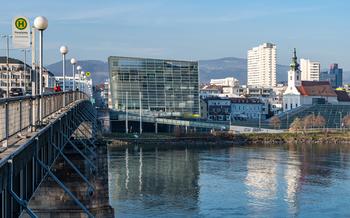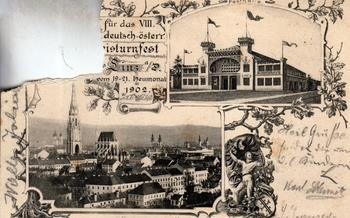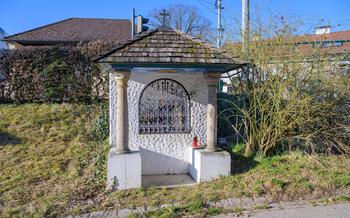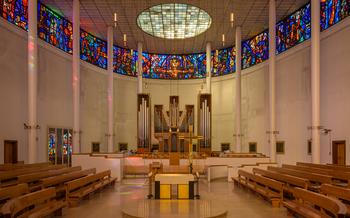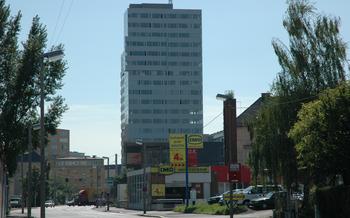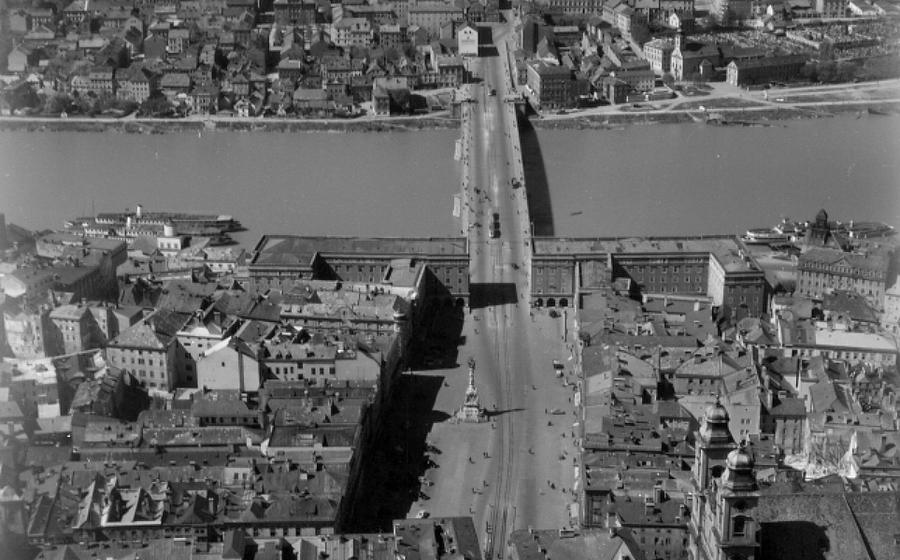
Museum of the History of Dentistry in Upper Austria
- A Journey Through Dental History
- Interactive Exhibits for All Ages
- The Dental Chair Display
- Tools and Equipment Throughout the Ages
- Oral Hygiene Practices in the Past
- The Role of Dentistry in Society
- Pioneering Dentists of Upper Austria
- Dental Art and Aesthetics:
- The Museum's Educational Mission
- Temporary Exhibitions and Events
- Guided Tours and Workshops
- The Museum Shop: A Treasure Trove of Dental Curiosities
- Accessibility and Facilities
- Location and Transportation
- Insider Tip: Unveiling the Museum's Hidden Treasures
A Journey Through Dental History
Embark on a fascinating journey through the rich history of dentistry in Upper Austria at the Museum of the History of Dentistry in Linz. Delve into the depths of this unique museum, housing an impressive collection of dental artifacts that narrate the evolution of dental practices and offer glimpses into the lives of remarkable dentists who shaped the field. Discover the stories behind their innovations and contributions, gaining a newfound appreciation for the complexities of dental care throughout the ages.
Interactive Exhibits for All Ages
The Museum of the History of Dentistry in Upper Austria is not just a place to learn about the past; it's also a place to have fun and engage with the history of dentistry in a hands-on way. The museum features a variety of interactive exhibits that are designed to appeal to visitors of all ages.
For children, there is a special section of the museum where they can learn about dental hygiene and the importance of taking care of their teeth. They can also try their hand at brushing teeth on a giant model and play games that teach them about the different parts of the mouth.
Adults will also enjoy the interactive exhibits, which include a virtual reality experience that allows visitors to see what it's like to be a dentist, and a 3D printer that can create custom-made dental models. There is also a touch screen that allows visitors to explore the museum's collection of dental artifacts in more detail.
The Museum of the History of Dentistry in Upper Austria is a great place to learn about the history of dentistry in a fun and engaging way. Whether you're a child or an adult, there's something for everyone to enjoy.
Anecdote:
A family with two young children recently visited the Museum of the History of Dentistry in Upper Austria. The children were immediately drawn to the interactive exhibits, and they spent hours playing games and learning about dental hygiene. The parents were also impressed with the museum, and they said that it was a great way to teach their children about the importance of taking care of their teeth.
The Dental Chair Display
At the Museum of the History of Dentistry in Upper Austria, a remarkable collection of antique dental chairs takes center stage. These chairs, intricately designed and meticulously crafted, offer a glimpse into the evolution of dental practices over the centuries. From ornately carved wooden chairs with intricate metalwork to sleek, modern chairs with adjustable features, the collection showcases the changing landscape of dentistry.
One particularly fascinating chair is the so-called "Barber's Chair." Dating back to the 18th century, this chair features a built-in headrest and armrests, allowing the barber-surgeon to perform dental procedures alongside other services. The chair's sturdy construction reflects the demanding nature of dental work in those days, when dentists often doubled as barbers or blacksmiths.
Another highlight of the collection is the "Pedal-Powered Dental Chair." Invented in the late 19th century, this chair was a marvel of engineering. It featured a foot-operated mechanism that allowed the dentist to raise and lower the patient's seat, providing greater comfort and efficiency. The chair's innovative design paved the way for modern dental chairs that prioritize both patient comfort and dentist convenience.
Tools and Equipment Throughout the Ages
The Museum of the History of Dentistry in Upper Austria houses a fascinating collection of dental tools and equipment that showcases the evolution of dentistry from its humble beginnings to the sophisticated practices of today. Visitors can marvel at the intricate designs and mechanisms of antique dental chairs, which played a crucial role in the history of dentistry. From simple hand-operated drills to modern electric tools, the museum's collection provides an insight into the remarkable advancements in dental technology.
The museum also displays a variety of dental tools, such as forceps, pliers, and excavators, which have been used for centuries to extract teeth, fill cavities, and perform other dental procedures. Visitors can learn about the materials used in the construction of these tools, from ivory and wood to stainless steel, and how they have evolved to meet the changing needs of dentists and patients.
One particularly unique item in the museum's collection is a rare set of gold-plated dental tools that belonged to a wealthy Viennese dentist in the 19th century. These tools, which are intricately engraved with floral motifs, offer a glimpse into the opulence and extravagance of dentistry during that era.
The Museum of the History of Dentistry in Upper Austria offers a comprehensive and engaging exploration of the tools and equipment that have shaped the field of dentistry. Whether you're a dental professional, a history enthusiast, or simply someone who is curious about the evolution of this essential healthcare field, you'll find something to fascinate and inspire you at this unique museum.
Oral Hygiene Practices in the Past
In the realm of oral hygiene, the past presents a stark contrast to the present. Dental care, as we know it, was virtually nonexistent, and people relied on rudimentary methods to maintain their teeth. Toothbrushes, as we imagine them, were not yet commonplace. Instead, people used twigs, rags, or even animal bones to clean their teeth. Toothpaste was also a foreign concept; salt, charcoal, and even honey were used as substitutes. These methods, while primitive by today's standards, served as the foundation for the sophisticated oral care practices we have today.
Challenges to oral hygiene were numerous. Poor nutrition, coupled with the lack of fluoride in water, resulted in rampant tooth decay. Dental cavities were a common ailment, leading to severe pain and discomfort. In the absence of effective treatments, tooth extraction was often the only solution. The loss of teeth not only affected a person's appearance but also had a significant impact on their ability to eat and speak.
The evolution of oral care products mirrored the advancements in dentistry. The first mass-produced toothbrush was introduced in the 19th century, followed by fluoride toothpaste in the early 20th century. These innovations revolutionized oral hygiene, leading to a significant reduction in tooth decay and gum disease. Today, we have access to a wide range of oral care products, including electric toothbrushes, dental floss, and mouthwash, which help us maintain healthy teeth and gums.
The Role of Dentistry in Society
Dentistry plays a crucial role in maintaining overall health and well-being. Healthy teeth and gums are essential for proper nutrition, speech, and social interaction. In the past, dental problems were often associated with shame and stigma. People with missing or damaged teeth were often seen as being lazy, unclean, or even morally corrupt.
Fortunately, attitudes towards dentistry have changed dramatically in recent decades. Today, dentistry is recognized as an essential part of modern healthcare. Regular dental checkups and cleanings are recommended for people of all ages. Dentists are now seen as trusted healthcare professionals who play a vital role in helping people maintain their oral health and overall well-being.
One of the most important roles of dentistry is to prevent dental diseases, such as cavities and gum disease. These diseases can cause pain, discomfort, and even tooth loss. By regularly visiting the dentist, people can catch and treat dental problems early on, before they become more serious.
Dentistry also plays an important role in restoring damaged teeth. In the past, people with missing or damaged teeth had few options for restoring their smiles. Today, there are a variety of dental treatments available, such as fillings, crowns, bridges, and implants, that can help people regain their lost teeth and improve their oral health.
The story of Maria, a retired schoolteacher, is a powerful example of how dentistry can transform lives. Maria had suffered from severe gum disease for many years. She was in constant pain and had lost several teeth. As a result, she was embarrassed to smile and avoided social interactions.
After years of suffering, Maria finally decided to see a dentist. The dentist diagnosed her with gum disease and recommended a course of treatment. Maria followed the dentist's instructions diligently, and within a few months, her gum disease was under control. She was no longer in pain and had regained her lost teeth.
Maria's life was transformed by dentistry. She was finally able to smile again and enjoy social interactions without embarrassment. She was grateful to the dentist for helping her regain her oral health and her confidence.
Pioneering Dentists of Upper Austria
Upper Austria has been home to a number of pioneering dentists who have made significant contributions to the field of dentistry. One such dentist is Dr. Johann Nepomuk Czermak, who lived from 1828 to 187Czermak was a renowned anatomist and physiologist who made important discoveries in the field of laryngology. He also invented the laryngoscope, a medical instrument used to examine the larynx.
Another notable dentist from Upper Austria is Dr. Ferdinand Ritter von Arlt, who lived from 1812 to 188Arlt was a pioneer in the field of ophthalmology and is credited with developing the first successful cataract surgery. He also founded the Vienna Ophthalmic Hospital, which is one of the leading eye clinics in the world.
These are just a few of the many pioneering dentists who have practiced in Upper Austria. Their contributions have helped to shape the field of dentistry and have improved the oral health of people around the world.
Dental Art and Aesthetics:
In the realm of dentistry, aesthetics plays a vital role in shaping smiles and boosting confidence. The Museum of the History of Dentistry in Upper Austria sheds light on this artistic aspect of dental practice. Visitors can marvel at the intricate designs of dental jewelry, dating back to ancient times when precious metals and gemstones adorned teeth as a symbol of wealth and status.
The museum also delves into the evolution of smile design, showcasing the techniques and materials used by dentists to create beautiful, natural-looking smiles. From porcelain veneers and composite bonding to teeth whitening and orthodontic treatments, visitors gain insights into the artistry behind modern dentistry.
One compelling story showcased at the museum is that of a patient who had been self-conscious about her discolored and misaligned teeth. Through the expertise of a skilled dentist, she underwent a smile makeover that transformed her appearance. The result was not just a brighter, whiter smile, but a renewed sense of confidence that radiated from within.
The Museum's Educational Mission
The Museum of the History of Dentistry in Upper Austria is dedicated to promoting dental health education and awareness. Through its interactive exhibits, educational programs, and workshops, the museum aims to inspire visitors of all ages to learn about the importance of oral health and the fascinating history of dentistry.
One of the museum's most successful educational initiatives is its "Brush-Up on Your Smile" program for children. This interactive program teaches children about the basics of oral hygiene, the history of dentistry, and the importance of regular dental check-ups. Children learn about the different types of teeth, how to brush and floss properly, and the effects of sugary foods on their teeth. The program is led by experienced dental educators who make learning fun and engaging for children.
The museum also offers guided tours for school groups, which can be tailored to specific grade levels and curriculum requirements. These tours provide students with a hands-on learning experience and the opportunity to ask questions about dentistry and oral health.
The museum's educational mission extends beyond its walls through outreach programs and partnerships with local schools and dental organizations. The museum's staff regularly visits schools to give presentations about oral health and the history of dentistry, and they collaborate with dentists and dental hygienists to develop educational materials and resources.
One of the most heartwarming stories about the museum's educational impact is that of a young girl named Sarah. Sarah visited the museum with her class on a field trip and was immediately fascinated by the interactive exhibits. She learned about the different types of teeth, how to brush and floss properly, and the importance of regular dental check-ups. After her visit to the museum, Sarah decided that she wanted to become a dentist. She went on to pursue a degree in dentistry and is now a successful practicing dentist. She credits her visit to the Museum of the History of Dentistry in Upper Austria as the inspiration for her career choice.
Temporary Exhibitions and Events
The Museum of the History of Dentistry in Upper Austria regularly hosts temporary exhibitions and special events to complement its permanent collection and educational mission. These exhibitions showcase a variety of dental-related topics, from the history of specific dental techniques to the latest advancements in dental technology.
Past exhibitions have explored themes such as "The Art of Dentistry: From Ancient Times to Modern Marvels," which showcased the intricate artistry and craftsmanship involved in dental work throughout history, and "The Science of Smiles: The Evolution of Orthodontics," which traced the development of orthodontic treatments from their early origins to the modern era.
These temporary exhibitions offer visitors a chance to delve deeper into specific aspects of dentistry, learn about the latest innovations in the field, and appreciate the rich history and cultural significance of oral care. Special events, such as lectures, workshops, and guided tours, are often organized in conjunction with these exhibitions, providing visitors with opportunities for hands-on learning and interaction with experts in the field.
Whether you're a dental professional, a history enthusiast, or simply someone with a curious mind, the temporary exhibitions and events at the Museum of the History of Dentistry in Upper Austria offer something for everyone. Be sure to check the museum's website or social media pages for upcoming events and exhibitions to enhance your visit.
Guided Tours and Workshops
The Museum of the History of Dentistry in Upper Austria offers guided tours that provide visitors with a deeper understanding of the museum's collection and the history of dentistry. Led by knowledgeable guides, these tours allow visitors to explore the museum's exhibits in a more interactive and engaging way. The guides share fascinating stories and anecdotes about the dental artifacts on display, bringing the history of dentistry to life.
In addition to guided tours, the museum also offers a variety of workshops and hands-on activities for visitors of all ages. These workshops are designed to make learning about dentistry fun and engaging. Children can participate in activities such as making their own dental tools or creating models of teeth. Adults can learn about the latest advances in dental technology or participate in discussions on oral health and hygiene.
One memorable guided tour at the museum was led by a retired dentist who shared his personal experiences and insights into the history of dentistry. He spoke about the challenges dentists faced in the past, the evolution of dental techniques, and the importance of oral health. The tour was not only informative but also inspiring, as it gave visitors a glimpse into the passion and dedication of those who have shaped the field of dentistry.
The Museum Shop: A Treasure Trove of Dental Curiosities
The Museum of the History of Dentistry in Upper Austria boasts a charming gift shop that caters to both dental enthusiasts and casual visitors alike. This treasure trove of dental curiosities offers a wide range of souvenirs, from quirky dental-themed mugs and magnets to educational books and replicas of historical dental instruments. Whether you're looking for a unique gift for a dentist friend or simply want a memento of your visit, the museum shop has something for everyone.
One of the most popular items in the shop is the "Tooth Fairy Kit," which includes a tiny tooth-shaped box, a wand, and a certificate for the recipient to fill out. This adorable kit is a perfect gift for children who have recently lost a tooth and are eagerly awaiting the arrival of the Tooth Fairy.
For those interested in the history of dentistry, the museum shop offers a selection of books, pamphlets, and DVDs that delve into the fascinating world of dental care throughout the ages. These publications provide insights into the evolution of dental practices, the lives of pioneering dentists, and the development of dental technology.
Proceeds from the museum shop directly support the museum's educational mission, helping to fund exhibitions, workshops, and outreach programs that promote dental health awareness and education. By purchasing a souvenir from the museum shop, you not only take home a piece of dental history but also contribute to the preservation of this important cultural institution.
Accessibility and Facilities
The Museum of the History of Dentistry in Upper Austria is committed to ensuring that all visitors have an enjoyable and educational experience, regardless of their abilities. The museum is fully wheelchair accessible, with ramps and elevators providing easy access to all floors. There are also accessible restrooms and a spacious café where visitors can relax and enjoy refreshments.
For visitors with special needs, the museum offers a variety of services, including guided tours in sign language and audio descriptions of exhibits. The museum staff is also happy to provide any assistance that visitors may require.
In one heartwarming instance, a visitor with a visual impairment was able to fully appreciate the museum's collection thanks to the museum's audio description service. The visitor was particularly moved by the story of a young dentist who had overcome great obstacles to achieve his dream of helping others. The visitor left the museum feeling inspired and grateful for the opportunity to learn about the history of dentistry in such an accessible way.
Location and Transportation
The Museum of the History of Dentistry in Upper Austria enjoys a prime location in Linz, nestled amidst the vibrant Landstraße district. Its convenient proximity to the city center makes it easily accessible on foot or by bike, allowing visitors to immerse themselves in the cultural and historical charm of Linz while exploring the fascinating world of dentistry.
For those arriving by car, ample parking is available nearby, ensuring a hassle-free visit. Additionally, the museum is well-connected to Linz's efficient public transportation network, with bus and tram stops situated just a short walk away. Whether you're a local resident or a tourist, reaching the museum is effortless, paving the way for an unforgettable journey through the history of dentistry.
Insider Tip: Unveiling the Museum's Hidden Treasures
Beyond the main exhibits, the Museum of the History of Dentistry in Upper Austria holds a treasure trove of hidden gems waiting to be discovered. For the curious and adventurous visitor, I recommend embarking on a guided tour to uncover these hidden wonders. The knowledgeable guides will take you behind the scenes, showcasing rare artifacts, forgotten stories, and the museum's ongoing research projects. Prepare to be amazed as you delve deeper into the fascinating world of dental history and gain an exclusive glimpse into the museum's most prized possessions.

